The streamlining of countless processes within the pharma industry has been possible thanks to mHealth devices and apps that promote data collection, patient engagement, and drug testing and control, among others.
The IT sector and the computer sciences industry have carried the weight of our world’s recent digital transformation. They have leveraged the digital rebirth of countless businesses that have casually implemented apps to broaden the scope of their operations. However, there are still industries whose modern processes are greatly affixed to the amalgamation of these technologies with their day-to-day operations. Healthcare and pharma are two of these sectors that have been reaping the benefits of said emerging mobile technologies–especially during the pandemic–and have adapted them to streamline their operations and suit their most pressing needs.
We had previously touched on the impact healthcare apps have had on medical care delivery; most of us have already witnessed and interacted with this modernization of the healthcare system somehow. We may have scheduled our doctor’s appointments online, downloaded lab test results from an app, or even accessed telehealth services. However, most people aren’t aware of how significant these modern technologies and mHealth apps have become for the digitization and automation of the pharma industry.
Still, the pervasiveness of mHealth apps for the pharma industry is not only about convenience; it’s about replacing traditional interventions and processes almost entirely. And even though mobile health apps are usually associated with a patient-doctor relationship, they are undoubtedly leveraging countless pharmaceutical processes. Furthermore, they aim to revolutionize the healthcare system and improve health care delivery outcomes, which means that their implementation in pharma–often underestimated–is crucial. For this reason, we wanted to provide some insight into how vital mHealth apps are for the pharma industry and how they are leveraging the industry’s digital revolution. But first, let’s give some context.

What are mHealth Apps?
mHealth is a broad term used to define the medical treatment and diagnosis practices supported by the employment of various applications used on mobile devices such as smartphones, tablets, patient monitors, wearables, or other wireless devices. In tandem with mHealth apps, patients use these devices to gather data about their current health conditions so physicians can safely access them and use them to treat diseases better and improve human health outcomes. For instance, a hypertense patient can be given a blood pressure monitor to collect readings about their daily–or weekly–fluctuations in BP. These readings, which are recorded and sent to the treating physician via a mHealth app, are analyzed to diagnose, record, and treat the patient and their existing condition in a more efficient, personalized way.
In addition to providing better treatment avenues, mHealth devices and applications help gather specific data about disease behavior and progression, genetic predispositions, medication dosages, and their side effects, to name a few. As a result, the global healthcare system has undergone a digital revolution that, when adopted on a larger scale, can help even the most vulnerable nations save valuable resources. It can also increase accessibility to medical care, provide self-care solutions that free physician workloads, and help the entire system attain an overall higher level of coverage that saves lives.
Yes, the benefits of mHealth solutions for both patients and physicians have been discussed for many years. However, only until the past few years have pharmaceutical companies begun to gain ground on the mHealth game. We can witness this increase by rewinding to 2013 when the number of mHealth apps produced by the twelve largest pharmaceutical companies only reached 305. Flash forward to 2017, and that number nearly tripled to reach 1.060 apps. Additionally, out of the 3.2 billion mHealth app downloads in 2016, 5.6 million were generated by pharma apps. These figures, which undoubtedly have increased by now, are a testament to the impact mHealth apps recently started to have in the industry. Surely, stakeholders have now realized how mHealth apps can be instrumental for the industry’s digital future.

How Are mHealth Apps Revolutionizing The Pharma Industry?
Added to what the previous statistics show us, the pandemic undoubtedly accelerated the steady increase in mHealth adoption by the pharma industry. Vaccine urgency and the increase in the demand for medications created a need for the sector to rapidly automate its processes without compromising the safety and quality of its products. Thanks to their portability and availability, mHealth solutions and the data collected from them played a crucial role in enabling pharma companies to access clinical patient information faster than ever. As a result, clinical studies and trials now have a more consistent and immediate flow of medical data that can provide pharma researchers more flexibility and direction to their tasks.
Moreover, mHealth can help bridge gaps between patients, doctors, and pharma companies by enabling communication highways where the medical data stream doesn’t stop at hospitals but instead flows through the entire healthcare system. This mHealth-powered sustained flow ensures that data reaches all relevant points, thus leveraging data-driven pharma research and cleaner manufacturing processes.
Additionally, with the help of modern technologies such as 5G mobile communications, advanced data analytics, IoMT, AI, and the rise of healthcare app developers, mHealth apps are getting bigger and better. They provide more actionable insights than ever before and are bound to become a necessary instrument for pharma companies to increase productivity and streamline internal processes. Furthermore, let’s consider that the global mHealth apps market was valued at $40.05 billion in 2020 and should grow at a compound annual growth rate (CAGR) of 17.7% from 2021 to 2028. Suppose mHealth apps keep growing at such a rate. In that case, we can safely conclude that the pharma industry will keep incorporating mHealth into its standard care practices and support more efficient, effective, and safer pharmaceutical care to patients.
Here are some of the most significant ways mHealth apps are helping drive efficiency and automate processes within the pharma industry.
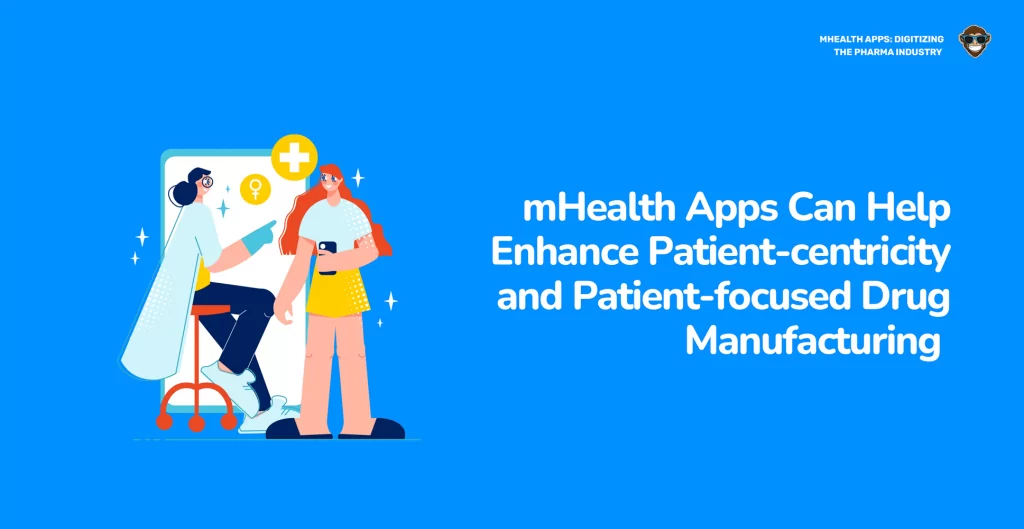
1. mHealth Apps Can Help Enhance Patient-centricity and Patient-focused Drug Manufacturing
With mHealth apps at hand, patients are no longer passive bystanders in managing their health conditions. Thanks to mobile technologies, people have become active participants in managing their treatments and health outcomes. Physicians can provide diagnoses and treatments more efficiently, thus avoiding unnecessary hospital stays and freeing workloads. Similarly, pharma companies use mHealth devices and apps to provide “beyond the pill” solutions that have completely changed and repurposed most drug manufacturing processes. As a result, they have shifted from a manufacturing-centered business model to a patient-centric model that uses mHealth tools to collect and analyze real-time data to give more direction to medical research and drug delivery.
The pharma industry has started to take advantage of the benefits of patient-centricity that doctors and hospitals have been mining for years. Thanks to mHealth wearables and apps, pharma companies can now capitalize on data provided directly by patients and engage with them in real-time, which before mobile technologies were unheard of. By having round-the-clock mobile interaction, pharma companies can deliver more patient-specific medications, thus ensuring their needs are met, and their health outcomes are better.
Furthermore, this precision drug manufacturing and consumption can also help identify side effects and adverse reactions during clinical trials in better, faster, more specific way. As a result, pharma companies no longer have to wait months to receive clinical trial results and interpret seas of generic data that reveal little or nothing about individual patients. They can now tap into data provided by mHealth tools or communicate with physicians and patients in real-time to gather actionable insight and data that can improve medication manufacturing and adherence.
For instance, Japan’s Takeda Pharmaceuticals, with who we’ve worked in the past, partnered with Koneksa, an American mHealth company, to collect patients’ vital signs, physical and sleep activity, and heart rate data, among others, using mHealth devices and monitors. The purpose of this partnership was to incorporate mHealth apps, wearables, and digital platforms in pharmaceutical research to gather specific data in clinical trials, focus their manufacturing processes, and improve the industry’s relationship with their end-users.
“Working with Koneksa enables us to take advantage of technologies and expertise that provide access to novel data streams and make our clinical trials more patient-centric,” Elena Izmailova, Ph.D., Takeda’s senior director of novel data streams and devices, said in a press release.
This push for pharma to connect with their end-users–their patients–can fortify pharmaceutical research and broaden the scope of which diseases drugs can cure. The careful monitoring of vital signs, test results, adverse reactions, and side effects can define the success of a specific medication or even guide research for new drugs and breakthroughs for diseases that have no cure yet. This increased targeting provided by mobile mHealth solutions and devices can help ensure pharma companies can deliver better therapeutic value with drugs that treat and prevent disease more efficiently.
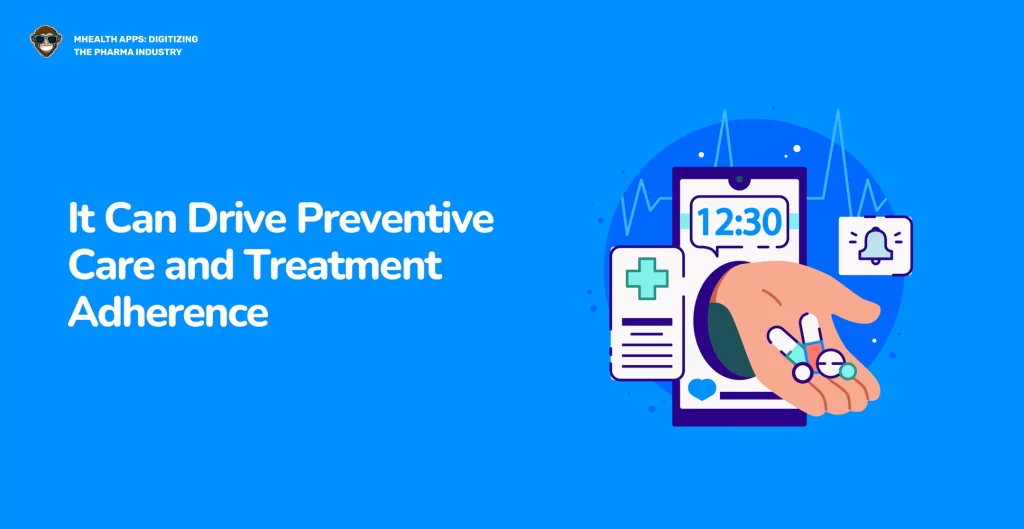
2. It Can Drive Preventive Care and Treatment Adherence
According to the Center for Disease Control and Prevention (CDC), preventable and chronic illnesses make up 90% of the US healthcare spending, which means that disease prevention strategies can significantly help reduce the healthcare system’s spending. On a global scale, the World Economic Forum predicted that the worldwide economic impact of chronic disease could reach $47 trillion by 2030. Therefore, the modern healthcare system must promote healthy habits, ensure patient engagement and adherence with their treatments and medications, and implement preventative approaches to health conditions. Luckily, mHealth apps are helping physicians and pharmaceutical companies accomplish these complex tasks by leveraging value-based medical delivery models, providing real-time medical data, and, as stated earlier, promoting patient-centric medical care.
One survey found that 60% of healthcare and pharma industry leaders consider patient engagement as one of the main drivers of disease prevention, high-quality medical care, and cost savings in the system. It’s important to understand that patient engagement depends on how much of their disease and treatment they know; you can’t play an active role on something you don’t fully comprehend. Unfortunately, pharma companies and patients don’t have a history of direct relationships. Historically, pharma has only established–business–relationships with doctors and hospitals through pharma reps. And, when pharma companies have developed their apps to reach out to patients, only 30% of users trusted them.
Therefore, it’s paramount for pharma companies to use the established mHealth technologies to reinforce patient engagement and help monitor and drive their adherence to treatments by increasing digital and health literacy. From a patient’s viewpoint, using an app to monitor their health condition can give them better awareness and understanding about the said condition and any potential drug side-effects. Simultaneously, pharma companies can leverage this search for understanding to reach out and gather insights and data to use in their manufacturing and marketing processes. As a result, they can produce more effective drugs, determine the proper dosage efficiency, furthermore accurate research, direct their marketing campaigns better, and enrich the annals of their research and clinical studies with first-hand, real-time data. It’s a win-win situation for all stakeholders.
Additionally, pharma can also take advantage of mHealth apps that assist patients with prescription filling and requesting. Using prescribing features in mHealth apps, patients can send prescription requests and feedback from their device directly to their pharmacy at any time from anywhere. Pharma companies can, in turn, monitor refills and medication adherence, which is a concerning issue for the pharma and healthcare systems. On this matter, studies show that almost 30% of medication prescriptions are never filled. Furthermore, 50% of medications are not taken as prescribed, which costs the US healthcare system $100 billion each year. Hence, the importance of patients, pharmacies, and physicians to leverage mHealth technologies to stay on top of medication adherence.
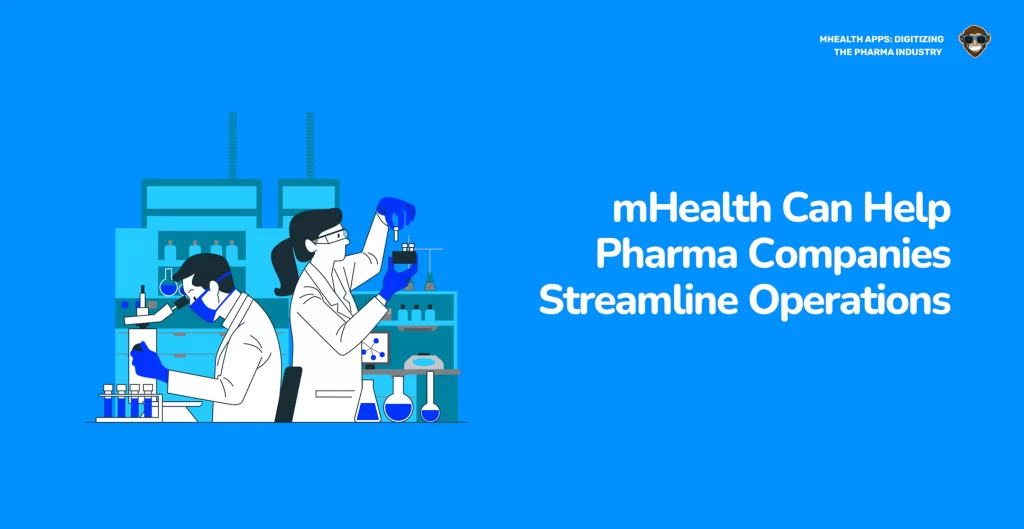
3. mHealth Can Help Pharma Companies Streamline Operations
We hope by now it’s clear that, for the pharma industry, mHealth apps and devices are key drivers of higher efficacy, digitization, data collection, patient-centricity, and better drug manufacturing processes. However, one key benefit for the industry is that mHealth apps can also be directed towards internal operations to increase productivity and streamline internal processes. MHealth apps and devices paired with advanced analytics, biometric sensors, and the automation of countless processes can help pharma companies increase the efficiency, speed, and quality of their business practices and internal operations.
Furthermore, they enable real-time transparency of clinical trials and provide data faster than ever, which can significantly reduce the $83 billion that pharma companies worldwide spent on the research and development of new drugs. As a result, new medicine manufacturing can become increasingly frictionless and cheaper, leading to smoother sales and operations and better supply chain functioning.
The mobile devices and mHealth apps essential for clinical data collection can also be valuable for pharma companies to recruit people for medical trials more efficiently. With an increase in the efficiency of communication channels provided by mHealth, there is also increased visibility for pharma companies. Thanks to that increased online presence, pharma companies can now disclose clinical trial practices and recruitment processes to make them widely available to the public. This visibility has led to an 80% increase in US registration rates for clinical trials than numbers from 2019. Similarly, patients are now more engaged with the pharma industry and interact with companies and doctors to help them produce faster results, better research, and more comprehensive reports.
At the same time, sales representatives are more informed and have better insight into what drugs and treatments are deriving more value. This way, they can add direction to their portfolios and transform how they present them to hospitals and doctors to increase sales margins. As a result, they can undoubtedly increase the precision of drug manufacturing, clinical trial completion and will surely propel more user-oriented marketing endeavors.
All of these newfound mHealth-powered interactions offer pharma companies the opportunity to potentialize internal processes and make better, data-driven decisions that add value to the entire system. The right combination of these data-driven insights provided by mHealth apps and modern pharma operations enables a complete shift in business models and global manufacturing practices. Thanks to this shift, pharma companies can now swiftly collect and analyze data from insurance providers, hospitalized patients, lab test results, sensors, and even social media, to generate palpable evidence about drug behaviors. As a result, long analysis processes and year-long research can be reduced to months, saving valuable resources for the industry.
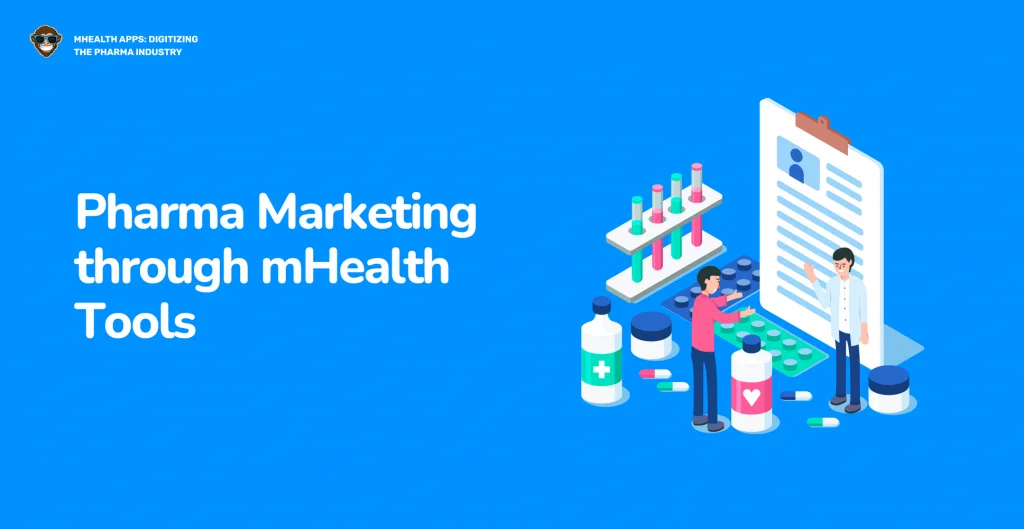
4. Pharma Marketing through mHealth Tools
There’s no denying that mobile technologies are a way for companies worldwide to leverage their sales and marketing campaigns to generate higher revenue rates. The pharmaceutical industry is no stranger to the power these mobile technologies have to drive sales through the roof and adapt to emerging trends. These trends indicate that producing and selling drugs is no longer enough to stay on top; they have to go beyond physical medicines and offer a complete medical care package to engage with users effectively. Accordingly, pharma marketers are increasingly adopting mHealth mobile trends to promote brand awareness, innovate the ways they advertise, and enhance communication efficiency with both doctors and patients.
Pharmaceutical and mHealth technologies also help sales teams move away from the traditional face-to-face selling sessions with doctors, which have become less effective and more of a hassle. A study from 2019 found that only 54% of doctors were accepting in-person visits from pharma reps. After the pandemic and the increased adoption of mHealth tools, that percentage will have indeed decreased by now. This phenomenon shines a light on the importance for pharma companies to innovate and leverage mobile technologies to further their sales growth. Thankfully, mHealth has helped pharma reps digitize their portfolios and include mobile tools to reach doctors and patients alike.
They have also developed their pharma apps with documentation and included digital academic material such as databases that users can easily access through mobile devices. This way, a mHealth-powered pharma app at the hands of a pharma rep can significantly improve physicians’ and patients’ responsiveness to pharmaceutical products. Mobile technologies go beyond any paper brochure or sales pitch to visualize the effects, benefits, risks, and functions of any pharmaceutical product. Furthermore, these digital tools can provide real-time visuals of the benefits of the products in question, for example, by exposing graphs, academic resources, and accurate data collected from trials and making it available for users to access from their phones.
Lastly, introducing mHealth apps and tools into the marketing strategies of pharma companies can help them reach patients directly, without the need for any intermediaries. This benefit can significantly improve the way users see pharma companies and help them navigate company information, get online customer service, and access medical data. They can also, for instance, compare prices, quality, packaging, and delivery methods of a specific brand of medications against others. As a result, the internal workforce and sales reps can constantly be up-to-date with what users prefer, the latest brand developments from competitors, and worldwide clinical trial outcomes, all in real-time.
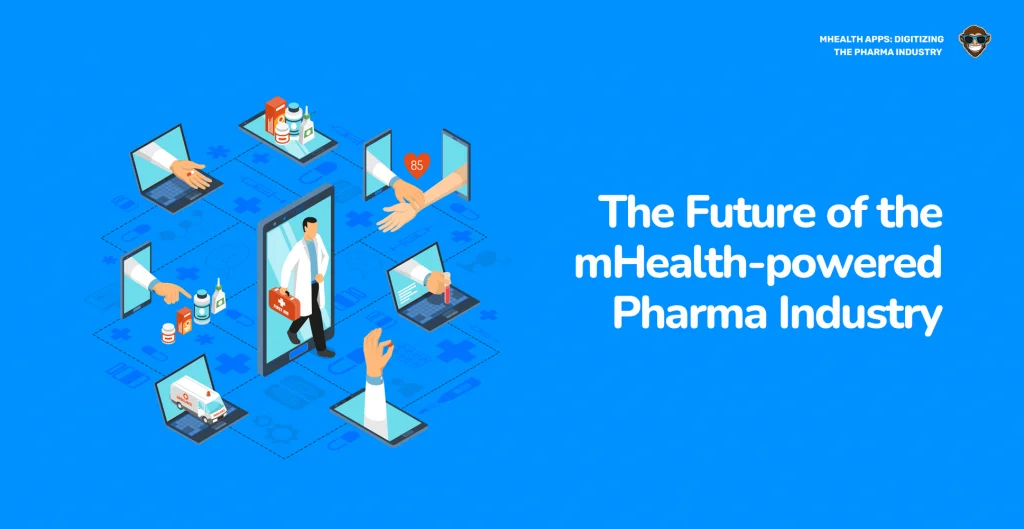
The Future of the mHealth-powered Pharma Industry
The digitization of pharma seems to be accelerating at incredible speeds, which means we will likely see pharmaceutical companies creating even more value through global mobile initiatives within the next few years. Many companies seem to be becoming a part of a digital healthcare ecosystem that, until a few years ago, only included bilateral relationships between patients and doctors or doctors and pharma, but never the omnichannel relationships between the three that we are starting to witness now. This newfound ecosystem will likely become commonplace in healthcare scenarios worldwide, thus helping improve health outcomes by enabling remote communication between stakeholders that can happen anywhere anytime. As a result, physicians will tackle diseases at early stages, prevent costly and deadly outcomes and, hopefully, eradicate certain conditions.
Pharma companies will, in turn, start to manufacture more specific drugs that target ailments in a more precise, efficient way. They will also start offering services that will go beyond medications and begin to play an even more active role in heightening the work of healthcare professionals and institutions.
Medications will always be essential, and the primary source of income for pharma, but their production process will be less reactive and more proactive. Drugs will be more specific and personalized thanks to advanced data analytics that enable information gathered from mHealth apps and devices to be used. These data points will undoubtedly help researchers detect illnesses before they appear, identify optimal therapies, discard useless and outdated drugs, and even predict how some individuals will respond to specific treatments. Such digital mHealth-enabled approaches will likely lead to faster FDA (or other regulatory entities) approval for medications, more collaboration between entities and stakeholders, and more trust in the pharma industry.
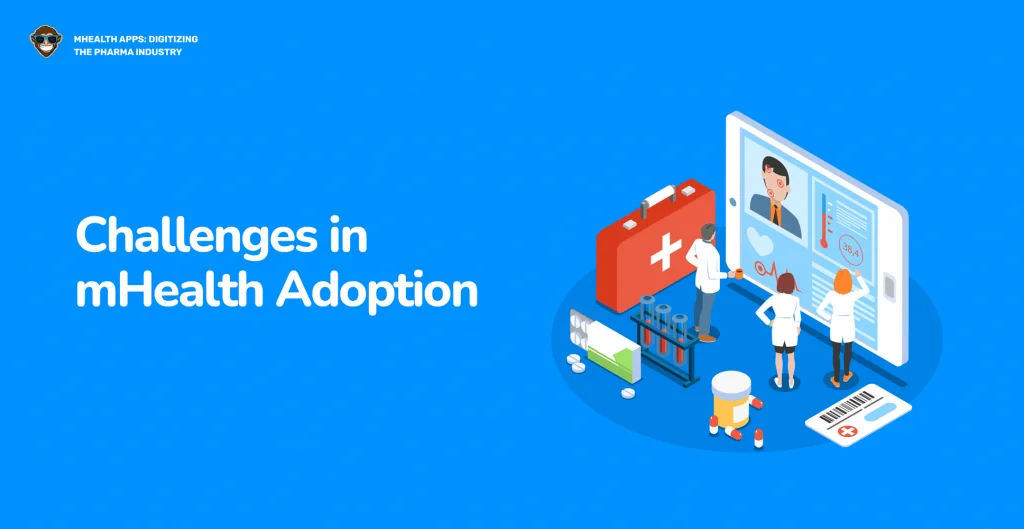
Challenges in mHealth Adoption
As time goes by and these technologies keep evolving, we will witness a wave of automation across the entire pharma industry that will positively impact the healthcare system and its outcomes. However, there will also be increasing challenges and a pressing need to address them to reap the benefits we’ve discussed in this article. Some of these challenges are:
- Data safety and privacy: The proliferation of mHealth apps raises concerns about the safety of the data stored and transferred between stakeholders. Furthermore, most users will surely prefer the anonymity of their data, which hinders patient-centric approaches to drug manufacturing.
- Regulatory uncertainty: Since these mHealth technologies are relatively new, there are still no global regulations or requirements as to the scope of how and when stakeholders can use these tools.
- Lack of Talent Availability: Managing and implementing effective mHealth-powered ecosystems require unique digital capabilities and skills that aren’t widely available.
- Lack of confidence in the sector: Despite its efforts, pharma still has an eroded relationship with consumers, and most of them will likely forever be reluctant to engage with the industry.
- Low tech and health literacy levels: Health and technical terms don’t come easy for most patients. Managing mHealth devices and using apps, synchronizing them, reading results, and overall interaction with these new tools will undoubtedly present challenges for patient engagement.
- Lack of collaboration between stakeholders: For these tools to serve their purpose, data must travel the entire system, from origin to end. That means there must be a constant collaboration between institutions, which doesn’t always happen and creates gaps in the transmission of information.
- Costs: Adopting these technologies will require funding that most practices and consumers in various world areas will not have.
These challenges are compounded by socioeconomic factors, government regulations, lack of infrastructure and efficient mobile networks, and outdated legacy systems and software in some territories. Still, as time goes by and these technologies keep disrupting industries worldwide, we’ll hopefully see an increased number of countries overcoming these challenges and adopting mHealth tools to further their healthcare needs and improve global health outcomes.
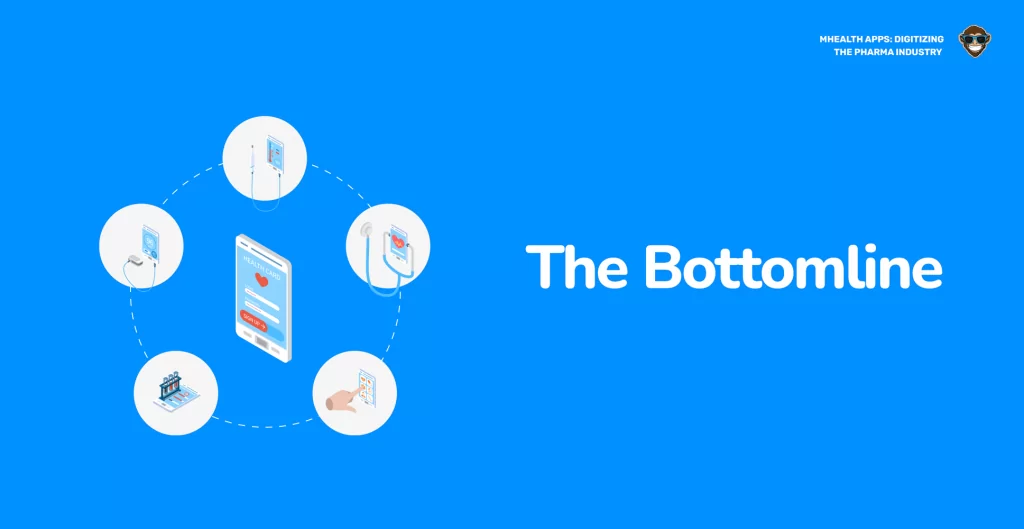
The Bottomline
In a nutshell, the impact of mHealth apps in digitizing pharma processes is genuine. They are helping the pharma industry evolve away from time-consuming, error-prone, and difficult to manage research practices and procedures and enter an era where trials and research are faster, better, and more user-oriented. And although not without its challenges, mHealth implementation within the pharma environment provides the opportunity to remotely connect with their end-users and collect insights that will help modernize the system. This modernization brought on by mHealth apps has enabled unified thinking to disrupt the outdated one-way communication channels that still exist and help develop a new connected universe for the patient-doctor-pharma triangle. All stakeholders will see the pharmaceutical industry become a more valuable part of the modern healthcare ecosystem. After all, they all have the same fundamental aim: create a better and more effective healthcare system that, as time passes, saves more lives.
As an experienced healthcare app development company, we’re more than happy to answer your questions regarding mHealth apps, and if you’re considering developing one, there’s no one better to help you do it. Let’s talk!
